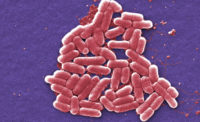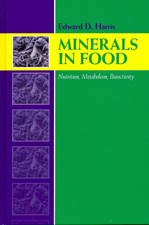In any manufacturing operation, attempting to adjust the process to correct for a defective component or ingredient can be nothing but frustrating when the supplier hasn’t done its job to provide a defect-free product. But suppliers (in this case, beef cattle growers) have had their hands tied when it comes to trying new methods to decrease E. coli counts in cattle before they enter the slaughtering plant.2

|
|
This colorized scanning electron micrograph (SEM) depicts a number of Escherichia coli bacteria of the strain O157:H7. Source: CDC.
|
According to a study from the US Government Accountability Office (GAO), USDA and university researchers have identified several treatments administered before cattle are slaughtered that could reduce Shiga toxin-producing Escherichia coli (STEC) in cattle. But these treatments have not been consistently applied. These preslaughter interventions include bacteriophages, prebiotics, probiotics, colicins, natural product extracts, vaccines and sodium chlorate (a chemical that kills the STEC O157:H7 strain).
However, few manufacturers have submitted applications for preslaughter intervention products to target STEC, according to officials from USDA and FDA. One exception, says the GAO report, is for vaccines to reduce STEC 0157:H7.
For preslaughter interventions, USDA exercises responsibilities for licensing and regulating STEC vaccines. However, USDA’s approval requirements for these vaccines are unclear, according to some industry representatives. Specifically, USDA’s general guidance does not address some of the unique challenges faced by manufacturers of animal health products seeking STEC vaccine approval, says the GAO report. For example, the guidance doesn’t explain that, if studies conducted in the lab are insufficient to demonstrate efficacy, the manufacturer would also need to demonstrate the vaccine is effective in a field setting such as a feedlot. In contrast, the Canadian Centre for Veterinary Biologics provides more specific guidance about when it requires the use of lab or field studies to demonstrate efficacy for vaccine license applications. Without guidance that provides clear and more specific information on what vaccine manufacturers need to submit, the approval process for STEC vaccines could face potential delays, says the GAO study.
In addition to STEC O157:H7, which USDA stated in 1994 was an adulterant, USDA in September 2011 determined six other STEC strains are adulterants in raw ground beef and trim. USDA has tests for these six strains and plans to use them in slaughter plants starting in June 2012. But according to GAO, it may be difficult and time-consuming to confirm positive test results because certain test components are either not commercially available for all strains or do not always provide clear results. USDA is working to improve the tests and find a commercial supplier for one key test component. (Beef Products Inc., anticipating the new ruling, already began testing for six other STECs last year; see “Beef processor steps up E. coli testing to serotypes,” FE Online.)
Some foreign governments already have practices that could be relevant to US efforts to reduce STEC in cattle, says the report. For example, the European Parliament and EU require verification of cleanliness by an inspector to ensure cattle are clean before going to slaughter. In contrast, USDA assesses the health of cattle, but not cleanliness. At least 12 EU member countries collected and reported data on STEC in live cattle in 2009. USDA has conducted STEC testing in live cattle, but has not tested since 1999. When a person becomes ill from E. coli in Sweden, government officials try to determine the specific farm that sold the contaminated cattle so that other carcasses from the farm can be tested for STEC. USDA, however, does not trace the STEC source back to the farm.
The GAO made two recommendations for the Secretary of Agriculture to take to resolve the delays in reducing E. coli counts. First, the secretary should direct the administrator of APHIS (Animal and Plant Health Inspection Service) to provide more specific public guidance on the license approval requirements for STEC vaccines to improve clarity and reduce delays. Second, the secretary should explore practices employed by other countries, which are not currently used in the US, and identify what practices may help alleviate problems here.
For more information on the GAO study, E. coli Contamination in Beef, visit www.gao.gov and search for “GAO-12-257.”






